| Organic Seeds | Edible Plants | Organic Pest Controls | Books | Tools, Propagation & Fertilisers | Sprouting & Microgreens | Poultry Supplies | Specials & Gift Ideas |

Top

We will send an email to this address*
when is next available
* we will use this email address only for this notification and then we will delete it.
 Home
Home
Green Harvest Organic Gardening Supplies is permanently closed as of 5pm on 1-11-2023.
We will not be taking orders by this website, in person, by phone or email. Our display garden and retail shop are closed forever.
Read more...
Phone:07 54357000
Phone calls will only be responded to sporadically and only in reference to orders placed prior to 2-11-2023. All the useful growing and organic pest management research and resources are available on this website for a while still.
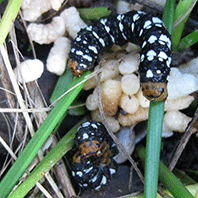 Caterpillars are the larvae of moths and butterflies, generally they eat leaves but some species feed inside
fruit such as Codling Moth and Budworms. The types that feed on leaves are the easiest to control organically.
Caterpillars are the larvae of moths and butterflies, generally they eat leaves but some species feed inside
fruit such as Codling Moth and Budworms. The types that feed on leaves are the easiest to control organically.Suggested Organic Strategies:
- HANDY HINT: Eating a leaf with a hole in it has no impact on human health!
- Handpick! Every caterpillar removed is one less adult laying eggs.
- Use a butterfly net to catch adult moths, this takes a bit of practice but it can be very satisfying.
- Sticky yellow traps are useful to trap small night-flying moths including budworms.
- Large pieces of eggshell can be scattered amongst cabbages to confuse the Cabbage white butterfly. The theory goes that it will mistake the eggshells for other butterflies and leave the area looking for less populated plants to lay its eggs on.
- Building the populations of natural predators is always worthwhile, so plant some Good Bug Mix!
- Exclude caterpillars by using Vege Net!
Organic Strategies for Caterpillar Control © Frances Michaels
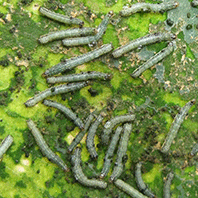
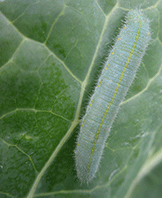 Caterpillars generally eat leaves but some feed inside fruit such as Codling Moth and Budworms. The types that
feed on leaves are easiest to control organically. Common pests in this group include Cabbage white butterfly
(pictured), Cluster caterpillar, Cabbage moth, Grapevine moth, Loopers, Light brown apple moth and Lawn armyworm.
The eggs of caterpillars are usually laid on the underside of leaves. Caterpillars are good at hiding themselves,
so usually it is leaves chewed full of holes that you notice first. Dark green droppings on a leaf are another
giveaway. Look carefully along the leaf veins and on the underside of the leaves for the culprits. Running your
fingers lightly under the leaf will usually cause enough movement to allow you to spot a well-camouflaged insect.
Before developing your pest management strategy, decide if you really need to do anything at all? Is it a plant
you care about; is the damage sufficiently bad to warrant your intervention? For example, the beautiful Large
Citrus butterfly does very little damage to citrus trees, losing a few leaves seems a small price to pay for
having it in your garden. If the answer is yes, then choose from several of the suggested physical, biological
and least-toxic chemical controls. Organic gardening relies on several overlapping strategies rather than the
power of a single highly toxic chemical to kill the pest.
Caterpillars generally eat leaves but some feed inside fruit such as Codling Moth and Budworms. The types that
feed on leaves are easiest to control organically. Common pests in this group include Cabbage white butterfly
(pictured), Cluster caterpillar, Cabbage moth, Grapevine moth, Loopers, Light brown apple moth and Lawn armyworm.
The eggs of caterpillars are usually laid on the underside of leaves. Caterpillars are good at hiding themselves,
so usually it is leaves chewed full of holes that you notice first. Dark green droppings on a leaf are another
giveaway. Look carefully along the leaf veins and on the underside of the leaves for the culprits. Running your
fingers lightly under the leaf will usually cause enough movement to allow you to spot a well-camouflaged insect.
Before developing your pest management strategy, decide if you really need to do anything at all? Is it a plant
you care about; is the damage sufficiently bad to warrant your intervention? For example, the beautiful Large
Citrus butterfly does very little damage to citrus trees, losing a few leaves seems a small price to pay for
having it in your garden. If the answer is yes, then choose from several of the suggested physical, biological
and least-toxic chemical controls. Organic gardening relies on several overlapping strategies rather than the
power of a single highly toxic chemical to kill the pest.General Physical and Cultural Controls
Handpicking is useful and very effective particularly if only a small number of plants are being attacked. Every caterpillar removed is one less moth laying eggs in the weeks to come. Carry a small bucket into the garden with you to collect caterpillars and other pests as a treat for your chooks.
Keeping a garden diary will help you to remember what not to plant! If a plant is being consistently attacked, try planting at a different time, taking earlier preventative measures or just not planting it at all. Strangely enough just planting a different colour can help, Cabbage White Butterflies are less likely to lay eggs on non-green Brassica so you can try red cabbage, purple kale or red bok choy.
Control Strategies for Cabbage White Butterfly
The Cabbage White Butterfly is a major pest of Brassica species (broccoli, cabbage, cauliflower, Asian greens) world-wide. It does a lot of damage early in the season as young plants have their growth set back by losing so much leaf area.
Decoys
Cabbage White Butterfly has a territorial behaviour pattern and this can be used against it. The theory goes that if it appears that many Cabbage White Butterflies are already present it will leave the area looking for less populated plants to lay its eggs on. So setting up decoys can help:
- The simplest is just to scatter large pieces of eggshell amongst the cabbages and broccoli. The additional calcium is a plus for the soil.
- You can make your own decoys out of white plastic or paper https://opengardensvictoria.org.au/Cabbage-Butterfly-Decoys
Exclusion and Netting
- A butterfly net is a surprisingly useful addition to your garden tools. It takes a bit of practice to catch Cabbage White butterflies but is an effective way to reduce numbers.
- If you can prevent moths from laying their eggs in the first place then you are way ahead. You can exclude caterpillars by using a fabric designed to cover vegetables such as a Vege Net or make innovative use of mosquito netting or old window screens.
Companion Planting Companion planting is used both for pest control and to encourage plants to grow well.
- Insectary flowers to feed the good bugs: buy Good Bug Mix here
- Trap crops to re-direct the egg-laying onto non-crop plants. In some cases these can be more attractive to the Cabbage White butterflies than the crop itself such as dill, nasturtium and mustard. Trap crops can also retard larval growth or actually kill the tiny caterpillars when they try to feed. Upland Cress has been shown to be an effective dead-end trap crop for several common pest moths and butterflies. Upland Cress leaves contain high levels of saponins and glucosinolates that attract the moths. The moths then lay their eggs on the leaves but when the caterpillars hatch, the larvae take a bite of the leaves and die.
- Living mulches confuse the adult moths and butterflies and make it difficult for them to find the crop. Examples of this include using white clover under crops of broccoli and cabbage. The crop plants need to be planted ahead of the living mulch to allow growth to take off without competition. It is believed the living mulch works in several ways, partly by masking the smell of the crop and partly by changing the appearance of the crop, especially the light levels. A groundcover such as white clover is also very attractive to beneficial insects.
- Repellent plantings to make the area undesirable to the pests. Strong smelling herbs with pungent smells have been used traditionally in both the garden and the home to keep moths at bay. Use hardy herbs suitable as a hedge around the vegetable garden such as wormwood, southernwood, sage, lavender and rosemary.
General Biological Controls
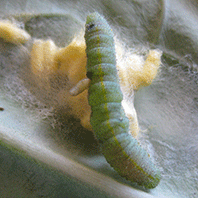
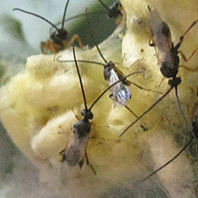 Enhancing the environment for the natural predators of caterpillars is a long-term strategy with the benefits
increasing over time.
Enhancing the environment for the natural predators of caterpillars is a long-term strategy with the benefits
increasing over time.
- Start by attracting small insect-eating birds by providing safe nest sites and a constant supply of water. Dense plantings of native shrubs, in out-of-the-way corners will provide nesting sites; prickly shrubs give added protection from predators.
- Nesting boxes for birds can fulfil an urgent need created by habitat destruction.
- Insect predators of caterpillars include: assassin bugs; tachinid flies; paper wasps, which chew up caterpillars and feed them to their larvae; lacewings and ladybirds eat moth eggs; tiny trichogramma wasps parasitise moth eggs; other tiny wasps like Apanteles sp. parasitise the caterpillar, the wasp larvae feed on non-essential parts of the caterpillar. When the wasp larvae are ready to pupate their exit generally finishes off the host caterpillar. Sounds gruesome but it is a part of nature.
Least-Toxic Chemical Controls
Choosing a least-toxic spray will reduce the impact on your good bugs! Dipel contains Bacillus thuringiensis, or Bt for short; it is highly effective and selective against most species of caterpillars. This biological control is a bacterial stomach poison for all caterpillars, which is mixed with water and sprayed onto foliage. It must be ingested by the actively feeding caterpillar, which dies 3-5 days later. It is totally safe to beneficial insects, bees and mammals. Bt is broken down by sunlight within a few days; so repeated applications may be necessary.
 Suggested Products:
Suggested Products:Amgrow Tomato and Vegetable Dust
Dipel
Exclusion
Pyrethrum
Sticky Yellow Traps
 Home
Home
Green Harvest Organic Gardening Supplies is permanently closed as of 5pm on 1-11-2023.
We will not be taking orders by this website, in person, by phone or email. Our display garden and retail shop are closed forever.
Read more...
Phone:07 54357000
Phone calls will only be responded to sporadically and only in reference to orders placed prior to 2-11-2023. All the useful growing and organic pest management research and resources are available on this website for a while still.
No liability will be accepted by Green Harvest, its owners or employees as to the accuracy of any information. No responsibility will be taken for damage to property or persons due to information given about a product or technique. No responsibility will be taken for the loss of a crop or income due to information given about a product or technique.
 Shopping here is private and secure.
Shopping here is private and secure.
Copyright © 2001 - 2024 Green Harvest Organic Gardening Supplies
No part of this website may be reproduced without permission of the owner